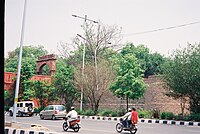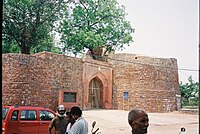India Gate and Rajpath
Situated along the ceremonial Rajpath avenue (meaning King's Way) in New Delhi, India Gate is a memorial raised in honour of the Indian soldiers who died during the Afghan wars and World War I. The names of the soldiers who died in these wars are inscribed on the walls. The (or shrine) in the middle is constructed with black marble and depicts a rifle placed on its barrel, crested by a soldier's helmet. Each face of the cenotaph has inscribed in gold the words Amar Jawan (in Hindi, meaning Immortal Warrior). The green lawns at India Gate are a popular evening and holiday rendezvous for young and old alike. Every year the Republic day celebrations are made in Delhi.The armymen and other citizens of India who awarded or who participate in the celebration walk through the Rajpath.[1]
[edit]Sansad Bhavan
Sansad Bhavan or the Parliament of India is a circular building designed by the British architects Sir Edwin Lutyens and Sir Herbert Baker in 1912–1913. Construction began in 1921, and in 1927 the building was opened as the home of the Council of State, the Central Legislative Assembly, and the Chamber of Princes.
[edit]Rashtrapati Bhawan
Built with a mix of Western and Indian styles, Rashtrapati Bhavan was originally built for the Governor General of India. Inaugurated in 1931 as the Viceregal Lodge, the name was changed in 1959 after India became a republic. Now it is the Presidential Palace of India.
[edit]Connaught Place
Connaught Place is one of the largest commercial areas in Delhi, India. It's also known as C.P
[edit]Mughal monuments
[edit]Humayun's Tomb
Humayun's Tomb was built for Humayun's widow, Hamida Banu Begum. Designed by a Persian architect named Mirak Mirza Ghiyas, the structure was begun in 1562 and completed in 1565. The tomb established a standard for all later Mughal monuments, which followed its design, most notably the Taj Mahal.[1]
[edit]Purana Quila
The Purana Quila (Old Fort) is a good example of Mughal military architecture.[1] Built by Pandavas, renovated by Humayun, with later modifications by Sher Shah Suri, the Purana Quila is a monument of bold design, which is strong, straightforward, and every inch a fortress. It is different from the well-planned, carefully decorated, and palatial forts of the later Mughal rulers. Purana Quila is also different from the later forts of the Mughals, as it does not have a complex of palaces, administrative, and recreational buildings as is generally found in the forts built later on. The main purpose of this now dilapidated fort was its utility with less emphasis on decoration. The Qal'a-I-Kunha Masjid and the Sher are two important monuments inside the fort. It was made by Aqeel in 1853.
[te]Red Fort
The decision for constructing the Red Fort was made in 1639, when Shah Jahan decided to shift his capital from Agra to Delhi. Within eight years, Shahjahanabad was completed with the Red Fort-Qila-i-Mubarak (fortunate citadel) — Delhi's seventh fort — ready in all its magnificence[citation needed] to receive the Emperor. Though much has changed with the large-scale demolitions during the British occupation of the fort, its important structures have survived.On every independence day the Flag of India is hoisted by the Prime Minister of India here.
[edit]Salimgarh Fort
 |  |
| Bahadurshah gate linking Red Fort and Salimgarh Fort through the arched bridge | Entry Gate to Salimgarh Fort (renamed as Swatantrata Senani Smarak |
Salimgarh Fort, which is now part of the Red Fort complex, was constructed on an island of the Yamuna River in 1546. But a gate called the Bahadur Shahi Gate for entry into the Fort from the northern side was constructed only in 1854-55 by Bahadur Shah Zafar, the last Mogul ruler of India. The gate was built in brick masonry with moderate use of red sandstone. The fort was used during the Uprising in 1857 and also as a prison which housed Zebunnisa daughter of Aurangzeb and the British imprisoned the freedom fighters of the INA. The layout of the Red Fort was organized to retain and integrate this site with the Salimgarh Fort through the Bahadur Shah Gate. The fort has been renamed as Swatantrata Senani Smarak and a plaque at the entrance to the fort attests to this.
[edit]Chandni Chowk
Chandni Chowk, a main marketplace in Delhi, keeps alive the city's living legacy of Shahjahanabad. Created by Shah Jahan the builder of Taj Mahal, the old city, with the Red Fort as its focal point and Jama Masjid as the praying centre, has a fascinating market called Chandni Chowk. Legend has it that Shah Jahan planned Chandni Chowk so that his daughter could shop for all that she wanted. The market was divided by canals. The canals are now closed, but Chandni Chowk remains Asia's largest wholesale market. Crafts once patronized by the Mughals continue to flourish there. Chowk is one of the oldest and busiest markets in central north Delhi, the Laal Quila (The Red Fort) and Fateh Puri Masjid. With the most famous mosque of Delhi Jama Masjid in the vicinity, along with Sis Ganj Gurudwara, Jain Mandir and a lot of small temples, the place witnesses a genuine cultural harmony
These mentioned places are so popular in Delhi, everyone who want know about Tourist Places in New Delhi, see these places and enjoy Delhi sightseeing.
ReplyDelete